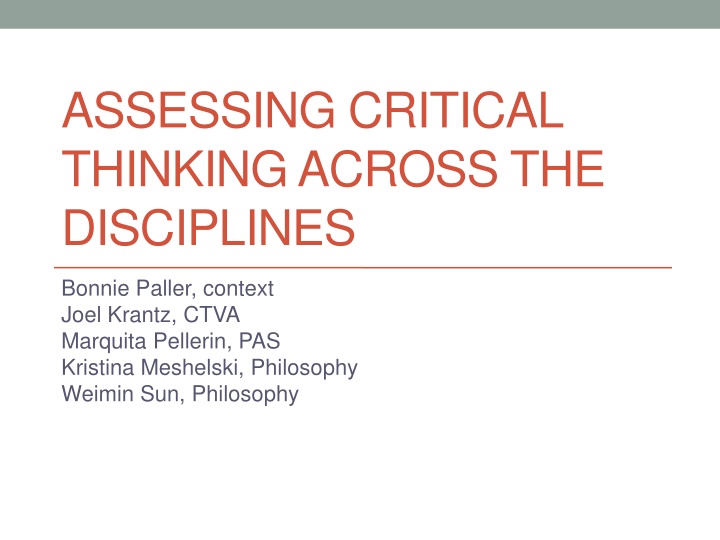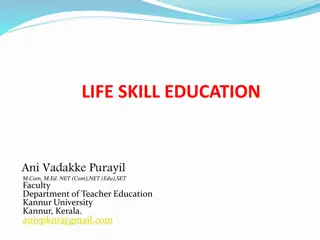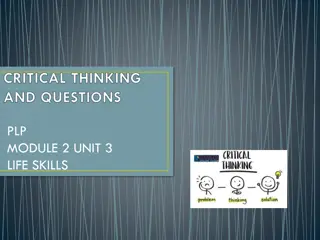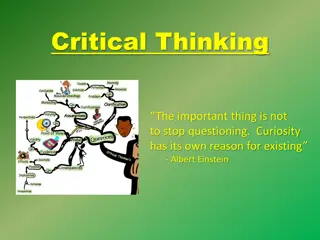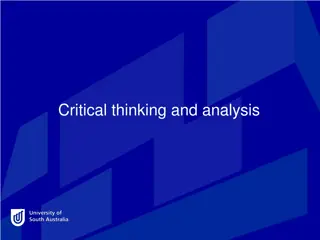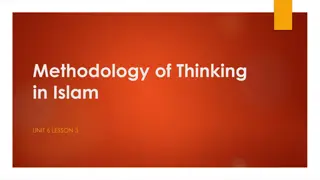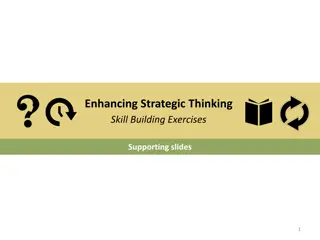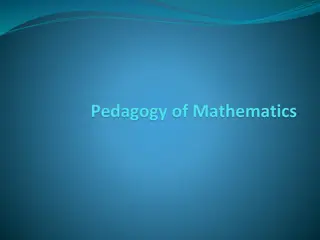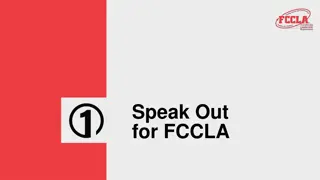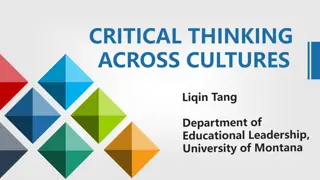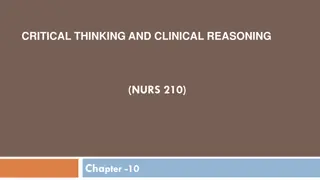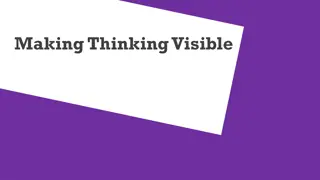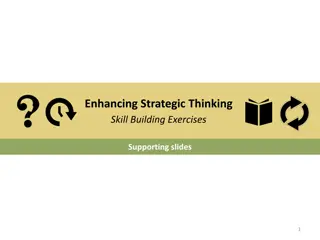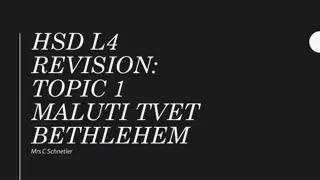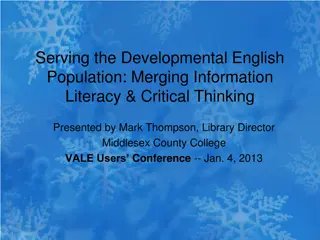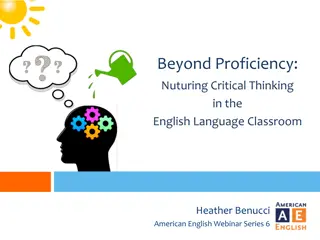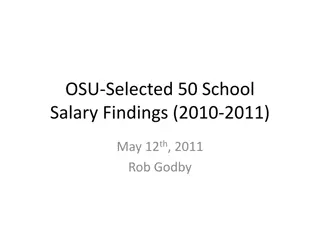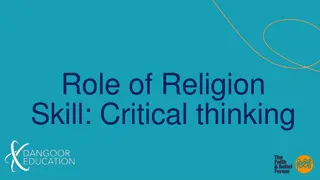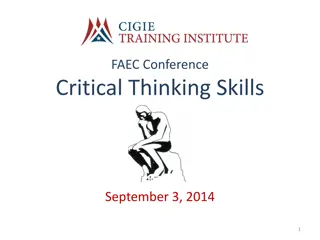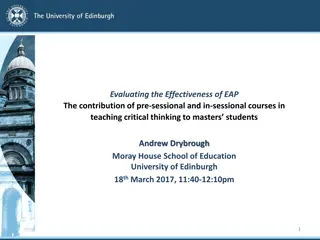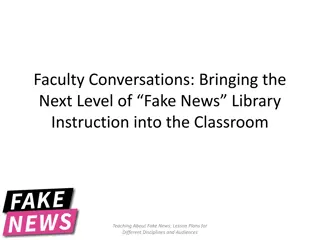Enhancing Critical Thinking Skills Across Disciplines
Explore strategies for fostering critical thinking skills through various disciplines, including identifying levels of critical thinking, designing effective assignment prompts, and addressing real-world issues like sustainability and political participation. Understand the importance of prompting reasoned judgment, meta-cognition, and cognitive skill development in students to cultivate strong critical thinking abilities.
Download Presentation

Please find below an Image/Link to download the presentation.
The content on the website is provided AS IS for your information and personal use only. It may not be sold, licensed, or shared on other websites without obtaining consent from the author.If you encounter any issues during the download, it is possible that the publisher has removed the file from their server.
You are allowed to download the files provided on this website for personal or commercial use, subject to the condition that they are used lawfully. All files are the property of their respective owners.
The content on the website is provided AS IS for your information and personal use only. It may not be sold, licensed, or shared on other websites without obtaining consent from the author.
E N D
Presentation Transcript
ASSESSING CRITICAL THINKING ACROSS THE DISCIPLINES Bonnie Paller, context Joel Krantz, CTVA Marquita Pellerin, PAS Kristina Meshelski, Philosophy Weimin Sun, Philosophy
BUILDING CRITICAL THINKING ASSIGNMENT PROMPTS Bonnie Paller AALC Retreat 2014 May 9, 2014
The assignment prompt design What level of Bloom s are you targeting? Is the assignment at the appropriate cognitive level: For the course? For its place in the semester? For its place in the program? How much scaffolding is assumed by the assignment? How will this assignment sequence to the next assignment or course?
Sustainability The nation is facing a variety of ecological problems that have the following general form: an established practice, whether on the part of business and industry or on the part of the public, is contributing to serious health problems for a large number of people. At the same time it would be costly to modify the practice so as to reduce the health problem. People often say that the answer is one of achieving a "balance" between the amount of money we spend to correct the problem and the number of lives we would save by that expenditure. Develop a point of view and some plausible criteria for telling how one would determine this "balance." Make sure you address any dilemmas inherent in your strategy for solving such problems.
What makes this assignment a good one? Critical thinking assignments identify a context and have a task description. Critical thinking assignments should identify and require students to use cognitive skills associated with critical thinking. Critical thinking assignments should ask questions requiring reasoned judgment within conflicting systems or complex questions requiring evidence and reasoning within one system. Critical thinking assignments should ask students to think about their thinking (meta-cognition).
Political Science There is a growing number of Americans who do not vote in national and local elections. Many of them explain their non-participation by saying that their vote would not make a difference. Some go on to argue that this is true because "money plays such a large role in elections that the candidate with the highest paid, and the highest quality, media campaign wins." Most people agree that money sometimes plays an inappropriate role in determining the outcome of elections. Develop a proposed solution to this problem that takes into account the view that people and organizations with money have a right to use that money to advance political causes they believe in. If you like, you may decide to develop a position to the effect that there is no solution to the problem and that we have no choice but to accept the status quo.
JOEL KRANTZ Mike Curb College of Arts, Media, and Communication Department of Cinema and Television Arts
Film Studies Critical Writing Prompt This semester, you learned that most films follow a Three- act structure , meaning that a film can be divided into three separate parts: Setup, Confrontation, and Resolution. Select one of the films screened in class this semester, and then write a critical essay which examines the film s adherence to the Three-act structure .
Assignment Prompt Help While the topic of the essay requires you to recount the story of the film, you should not stop at mere summary. Instead, explain how each event fits into the underlying structure of the film. The paper must offer analysis, not just summary. Your conclusion should place the thesis of the paper in a larger context, showing that despite the apparent rigidity of the Three-act structure , the structure still leaves room for variation.
Connection to Blooms Taxonomy The film studies critical writing assignment has a direct connection to Bloom s Taxonomy by requiring: Analyzing: Examination Creating: Conclusion
CTVA Film Studies Grading Rubric for Critical Thinking (4 points) The paper offers plentiful, detailed, subtle and strongly relevant evidence/film analysis. (3 Points) The paper offers substantial evidence/film analysis to support the argument. (2 Points) The paper offers evidence/film analysis, but it could be more complete or relevant. (1 Point) The paper offers thoughts, opinions and hearsay, but no solid evidence or film analysis.
TEACHING CRITICAL THINKING Dr. Marquita Pellerin Assistant Professor Pan African Studies
Written Critical Thinking Critical Response Paper Assignment Prompt- Sample 1: Students are to submit critical responses of 5 pages typed (double- spaced, font size-12), addressing a course reading from the current week (Student s Choice). A total of 5 Reading Response papers are to be submitted. [Late papers are not accepted]
Critical Response Paper: Evaluation Rubric Assessment Criteria 0 1 Summary of author s central argument author s central argument showing no ability to identify and summarize main points. points. 2 Limited articulation of author s central argument showing fair ability to identify and summarize main points. 3 Good articulation of author s central argument showing good ability to identify and summarize main points. 4 Very good articulation of author s central argument showing high ability to identify and summarize main points. 5 Outstanding articulation of author s central argument showing excellent ability to identify and summarize main points. Outstanding applications of original assessment of author s work demonstrating excellent ability to analyze in order to form new arguments. Outstanding development of original claims showing excellent ability to critically examine and challenge the author s central argument. Outstanding use of examples/illustrations from the author s text that demonstrate excellent ability to synthesize evidence in analytical way to formulate clear conclusions. Lack of articulation of Poor articulation of author s central argument showing lack of ability to identify and summarize main Thesis Lack of applications of original assessment of author s work demonstrating no ability to analyze in order to form new arguments.ck of Lack of development of original claims showing no ability to critically examine and challenge the author s central argument. Poor applications of original assessment of author s work demonstrating lack of ability to analyze in order to form new arguments. Poor development of original claims showing lack of ability to critically examine and challenge the author s central argument. Limited applications of original assessment of author s work demonstrating fair ability to analyze in order to form new arguments. Limited development of original claims showing fair ability to critically examine and challenge the author s central argument. Good applications of original assessment of author s work demonstrating good ability to analyze in order to form new arguments. Good development of original claims showing good ability to critically examine and challenge the author s central argument. Very good applications of original assessment of author s work demonstrating high ability to analyze in order to form new arguments. Very good development of original claims showing high ability to critically examine and challenge the author s central argument. Claims Evidence/ Support Lack of use of examples/illustrations from the author s text that demonstrate no ability to synthesize evidence in analytical way to formulate clear conclusions. Poor use of examples/illustrations from the author s text that demonstrate lack of ability to synthesize evidence in analytical way to formulate clear conclusions. Limited use of examples/illustrations from the author s text that demonstrate fair ability to synthesize evidence in analytical way to formulate clear conclusions. Good use of examples/illustrations from the author s text that demonstrate good ability to synthesize evidence in analytical way to formulate clear conclusions. Very good use of examples/illustrations from the author s text that demonstrate high ability to synthesize evidence in analytical way to formulate clear conclusions. Implications Lack of discussion of the implications demonstrating no ability to support new arguments. Poor discussion of the implications demonstrating lack of ability to support new arguments. Limited discussion of the implications demonstrating fair ability to support new arguments. Good discussion of the implications demonstrating good ability to support new arguments. Very good discussion of the implications demonstrating high ability to support new arguments. Outstanding discussion of the implications demonstrating excellent ability to support new arguments.
Critical Response Sample Paper #1 Does the phrase, innocent before proven guilty ring a bell? Within chapter two, entitled, The New Jim Crow, Michelle Alexander discusses the difference between the real criminal justice system and the made for TV criminal justice system and how both of them function totally different from one another. The criminal justice system that has been enforced in real life is actually not a pleasant one Full-blown trials of guilt or innocence rarely occur; many people never even meet with an attorney; witnesses are routinely paid and coerced by the government; police regularly stop and search people for no reason whatsoever; penalties for many crimes are so severe that innocent people plead guilty, accepting plea bargains to avoid harsh mandatory sentences; and children, even as young as fourteen, are sent to adult prisons. (pg.59 ) with this being stated, it almost as if television gives an illusion of the real life criminal world. It s unfortunate that the treatment of black males is very poor when it comes to the criminal justice system.
Written Critical Thinking Critical Response Paper Assignment Prompt-Sample 2: Students must provide a 5-page critically evaluation of one of the weekly reading. Students must identify and summarize the main points of the article. Critically examine and analyze the author s central argument in order to develop an original thesis. Introduce major claims that support your thesis and provide examples that support your claim. Students must also discuss how the implications of their claims impact the African American community. Finally, provide a clear conclusion.
Sample Critical Response Paper #2 Welch (2007) discusses the impact of the stereotyping effect on racial profiling of Black Americans as criminal offenders. Through a content analysis, Welch explains this phenomenon through a critical analysis of previous research that sampled African Americans throughout American History. This research attempts to understand how Black criminal stereotypes have been used to justify racial profiling. The researcher found that while Blacks are indeed disproportionally arrested for crimes, the public sentiment does not accurately reflect African Americans involvement in criminal activity. These findings reveal that there exists an embedded assumption about Black Americans which directly leads to Blacks being stereotyped as criminals, and may in turn cause law enforcement to unfairly target African Americans. Although Welch was able to provide an analysis of previous research to support her claim that Black criminal stereotypes lead to racial profiling, she failed to adequately link these stereotypes to the racism embedded in American society, which if left unaddressed will aid in the continuation of profiling Blacks as criminals. Even though Welch identifies the fact that since the Civil Rights era a link between crime and African Americans was developed, she neglects the role of the pre-Civil Rights era of Jim Crow in creating these stereotypes in the first place. The stereotyping of Blacks as criminals is historically rooted in the 19thcentury race-based notions of Blackness. According to Michelle Alexander, in The New Jim Crow, this era placed African Americans in position of second-class citizenship in the same way that mass incarceration currently places those convicted of felonies. Yet, Welch fails to mention this connection. Instead, Welch focuses on the role that the media plays in perpetuating these ideas linking Blacks to criminal activity . According to Welch, the media provide readily accessible depictions of criminality, which may help to shape perceptions about crime and subsequent justice practices (281). While this may be true, any accurate discussion of the role of the media must take into consideration that from which media has adopted these concepts. Given Welch s argument that the common stereotype of Blacks as criminals has erroneously served as a subtle rationale for the unofficial policy and practice of racial profiling by criminal justice practitioners, it is vitally important that research connect these practices to the historical foundations of race in America in order to challenge and ultimately change these systems.
Oral Critical Thinking: Debate Presentations Assignment Prompt: Each student will need to select a debate topic and there will be 3 pro and 3 con slots available for each debate . The debate presentations will follow an 18 minute format and this format will include a 3 minute introduction, 3 minute rebuttal, and a 3 minute closing for each debate group. The only material that each debater can use is one 3 by 5 note card . At least two class readings and two outside sources must be used to support the debaters claims. Students are required to develop a three part argument for or against their topic that analyzes the issue in relation to its impact on the African American community. Students are expected to incorporate quantitative evidence to support their claims. Students must analyze and respond to the opposing team s argument. Your debate group will be expected to answer questions from the audience after your presentation. Students must turn in a list of references used in the debate. explore s and critically
Oral Critical Thinking: Evaluation Rubric Criteria 1 Point (each) 2 Points (each) 15 Points Presentatio n Unclear & Poor time management . Poor synthesis of evidence resulting in weak argument. Poor critique of opposing argument & no use of sources. Timely but limited clarity in argument. Presented a timely clear debate. Argument Limited synthesis of evidence leading to fair support for argument. Limited evidence for challenging opposing argument. Synthesized evidence in analytical way to formulate clear argument. Critically examined and challenged the opposing argument with evidence Addressing Opposing Argument Addressing Audience Questions Relied too heavily on opinions and not authorities. Limited use of authorities in response to questions. Limited use of empirical research . Accurately relied on authorities in response to questions. Sources Lacked empirical evidence to support claims. Incorporate d quantitative data to support claims.
Oral Critical Thinking Student Evaluation Form: Your group s debate presentation was evaluated on the five categories listed below. Each category is worth three points. The debate presentation is worth a total of 15 points. Comments at the bottom of the evaluation will provide further clarity for your group s score. Presentation Addressing the audience questions Answer questions _______ Incorporate quantitative support __ Clarity of Response ________ Time ________ Flow ________ Clarity ________ Argument Support for Claims ________ Accuracy ________ Strength ________ Sources List of References ________ Empirical Research _________ Validity of Sources _________ Addressing Opposing points Use of Sources ______ Strength _______ Clarity _______ Total Points Earned _______ Comments:
Sequenced revisions of an assignment prompt Weimin Sun, Philosophy Assignment 1 After listening to Dr. A & B s talks and reading the accompanying pieces, what parts did you find clever and why, or what parts didn't hold water for you and why? You may also comment on other student's comments. At the very least, give a dissection of part of someone's argument, pointing out premises and conclusions.
Reasons to revise assignment 1 This is the first assignment for this critical thinking course. The initial assignment 1 did not give specific details on what we look for from students critical responses, and we get varied responses from students. As a result, we revised the assignment to make sure that students would think critically about the issues.
Assignment 1 --revised We just had two great lectures. In your critical response, please address the following questions. 1. What did the speakers try to argue for? That is, what are their main theses? Try to state as clearly and precisely as you can. 2. Detail some arguments that the speakers used to support their main idea. 3. Are there any differences between Dr. A and Dr. B's views on human nature? If so, what are their differences?
The assignment revised again - students are asked to apply more critical thinking tools (e.g. argument evaluation and argument development): Both Prof. A and B s talks are very stimulating, and are nice topics for your critical review. Try to answer to the following questions in your critical review, and analyze them in a deeper way. 1.What is Prof. A s main thesis in her talk? (That is, what does she try to argue for?) How does she support her thesis? 2. Do you agree with Prof. A s position or her arguments? Is there anything that you think needs to be better clarified or supported? 3. What is Prof. B s main thesis in his talk? (What does he try to argue for in his talk?) And how did Prof. B argue for his main position? 4. Do you agree with Prof. B s position or his arguments? Why or why not? Give some detailed reasons to support your own position.
Kristina Meshelski, Philosophy Can a machine think? Discuss Turing and Searle in your paper. Bloom s Taxonomy: Evaluate
Helpful Hints 1. Start your paper with a fact or a story, not a generalization. named Watson beat both Ken Jennings and Brad Rutter on the game show Jeopardy! NOT People have argued about the mind since the beginning of time. Avoid talking about the past like this, it is too general. e.g. Descartes believes that the mind and body are separate. Or In 2011 a computer system 2. Showwhy an argument is bad; don t just say that it is bad. make a distinction between acting as if you are in some mental state and actually being in that mental state. NOT simply Turing s argument is hard to believe. e.g. Turing holds that thinking is simply a matter of acting as if you are thinking. But usually we 3. Do not argue from authority. doesn t matter who said this, in your paper you must give reasons for the claims you are making, so if you want to quote an outside source in this manner you must tell us the reasons that Science magazine says that thinking is a matter of neural networks connecting. The fact that someone said this is not reason enough to believe it, even if that someone is a famous philosopher. e.g. Thinking is a matter of neural networks connecting, according to Science magazine. It 4. Do not rely entirely on empirical claims. identical to the physical state of low seratonin. This claim, if properly cited, can be used in a paper. But a scientific study cannot be your only argument for your thesis. You must say something more. e.g. Studies show that depressed people have low levels of serotonin, therefore depression is
Philosophy Department Critical thinking rubric This is one part of a larger rubric that we use to evaluate argumentative essays. In addition to evaluating argument, shown here, we also evaluate exposition, organization, and writing using the same 0-4 scale. March 28, 2014 Argument An Exemplary Paper Presents strong and well- developed arguments in support of its central claims 4 3 2 1 0 An Unsatisfactory Paper Fails to adequately defend its central claims Acknowledges and supports other controversial claims asserted and/or relied upon in the paper Treats controversial claims as needing no support Presents any relevant objections and counterarguments to its central claims and arguments Fails to present objections or counterarguments to its central claims and arguments Offers strong arguments to defuse objections and counterarguments to central claims and arguments Does not respond adequately to objections and counterarguments to central claims and arguments Is subtle, original, and/or insightful Is trite, trivial, or unoriginal
What do you think? Utilizing the above information, and the Affective, Cognitive, and Behavioral Components from The Critical Thinking Process document, answer the following questions and submit your written response in essay form to the Judicial Affairs office, srhoten@fullerton.edu, by 5:00 PM on the date specified on your Administrative Review form. Your essay must be 2-3 pages: typed, double-spaced, 12-point type, properly cited, with appropriate language, grammar and spelling. 1. Identify the issues which caused you to be referred to the Judicial Affairs Office. 2. Analyze the facts about the incident and explain how you made your decisions. 3. Evaluate your actions and assess how you now see how you used information to make your decisions. 4. What conclusions can you make about how you made your decisions? 5. Explain the assumptions that you had that caused you to take these actions. Why were these assumptions faulty? What information did you fail to consider? 6. How did your behavior impact other members of the community? 7. What have you learned from this incident and completion of this exercise? 8. What will you do differently in the future in terms of the decisions you make?
Want to work on an assignment prompt? Contact: Krantz, Joel joel.krantz@csun.edu Meshelski, Kristina kristina.meshelski@csun.edu Pellerin, Marquita M marquita.pellerin@csun.edu Sun, Weimin weimin.sun@csun.edu
